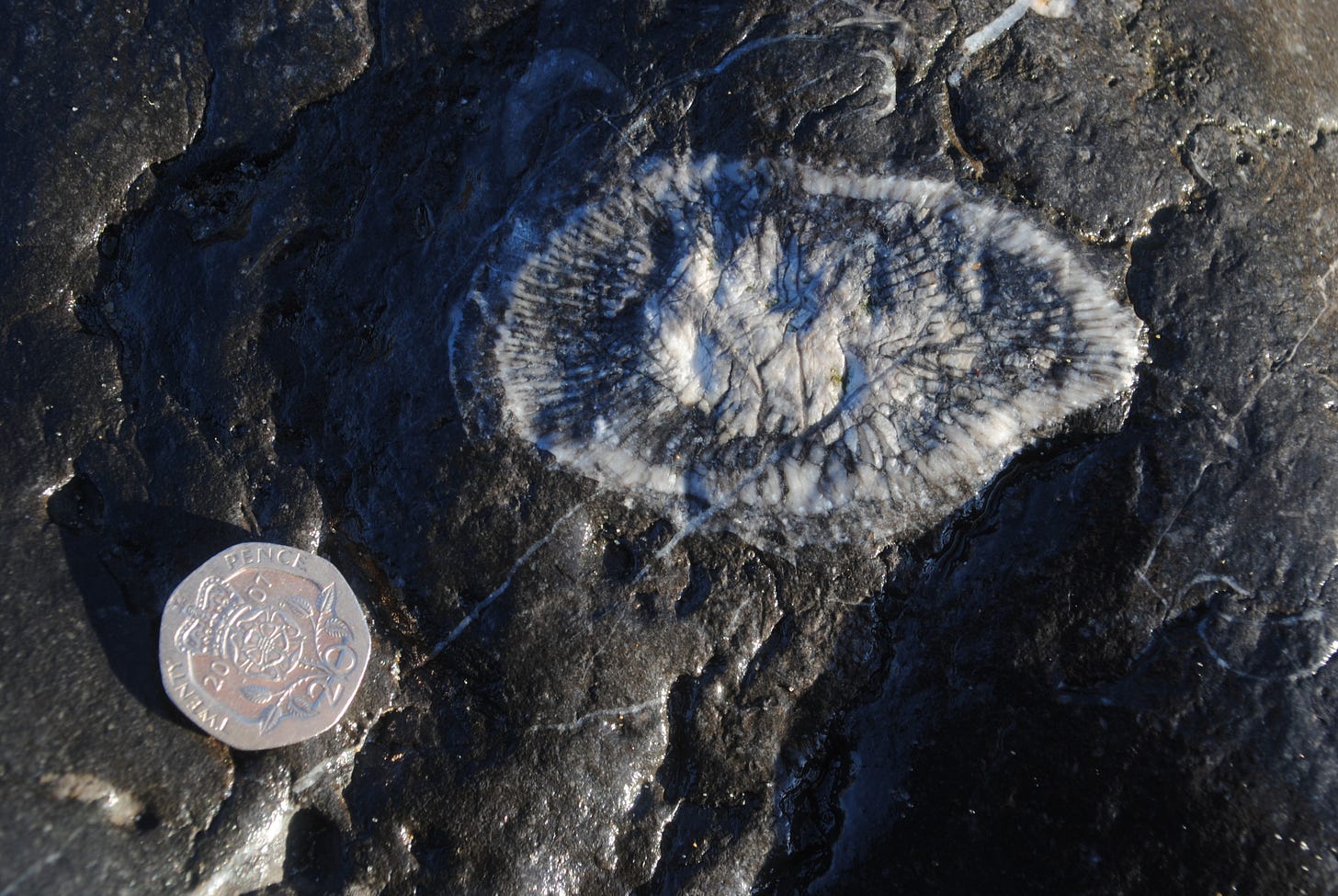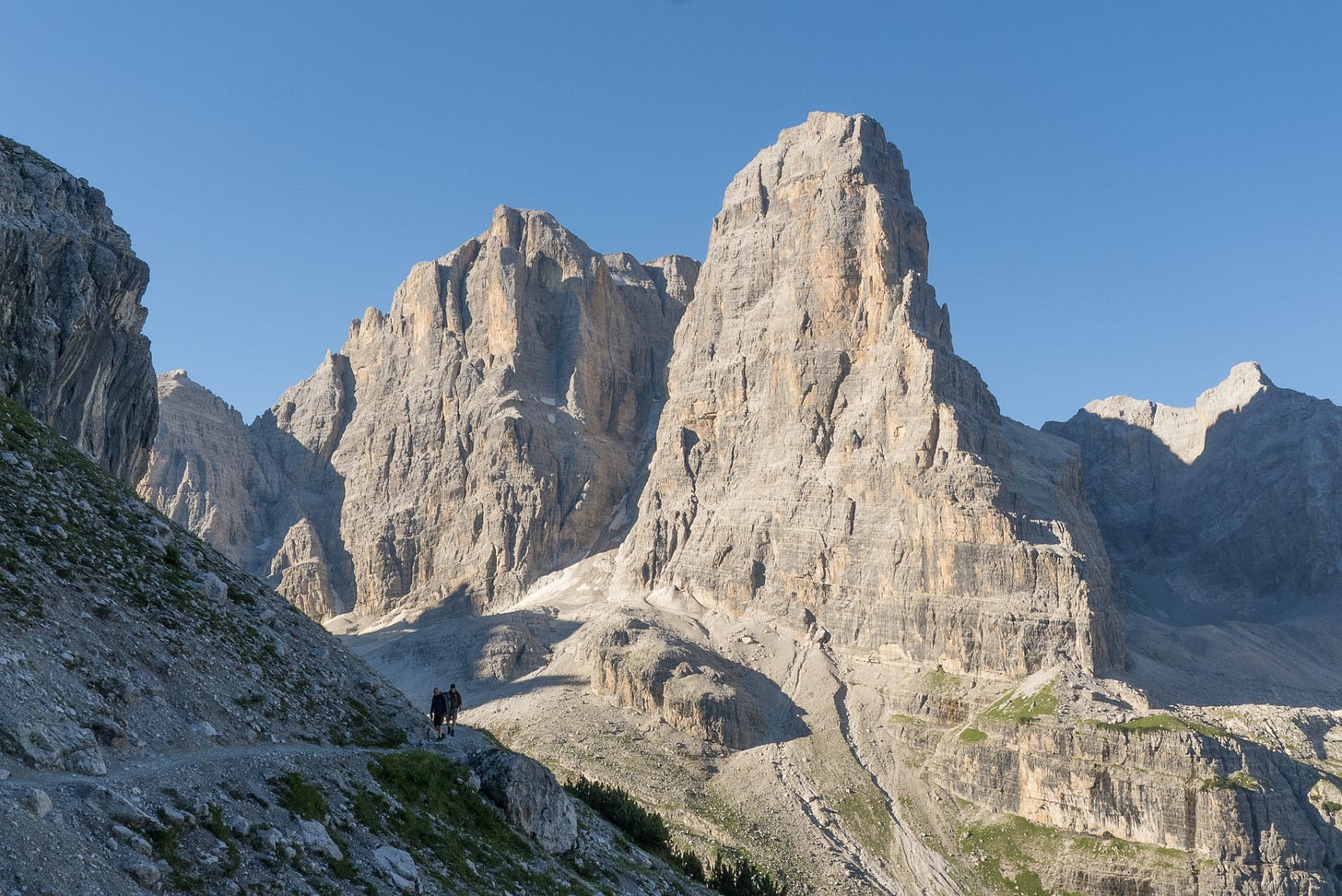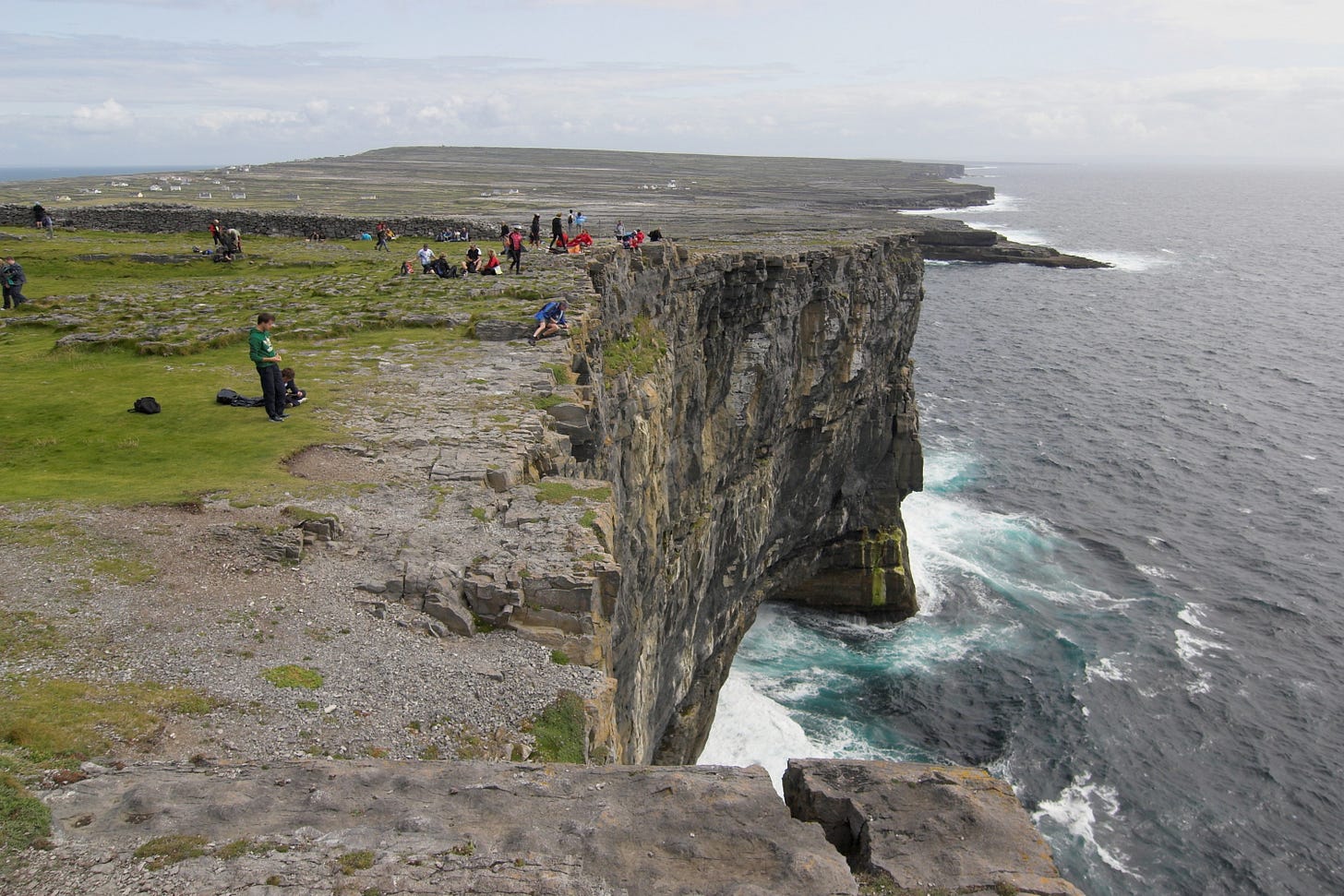In the sunshine, the hot grass smelled like new-mown hay. A couple of butterflies flitted around the bottom ends of my walking poles. I stopped at the low pass, and looked down on an extremely odd landscape.
Mountain ground ought to be cliffy, and vertical, and pointy all along the top. But this was almost flat. A bowl of wrinkled grey limestone, like porridge left too long to go cold. A little path that vanished as it wandered over the bare rock. And somewhere down over the edge of it all, a distant grey-green valley.
A fortnight later, a weird sense of déja view. The same wrinkly limestone landscape hemmed in by little hills. The same small yellow flowers; the same blue valley far below. But this time I wasn't in the Yorkshire Dales, somewhere on the lower slopes of Ingleborough.
This time, I was in Italy.
All over Europe, rock made of ancient seabed and small seashells rises in towering mountains all coloured in the off-white shades of a daydream: the Picos de Europa, the Julian Alps of Slovenia, the Dolomites.1
As Africa approaches, the former shelly seabed of the former Tethys Ocean is raised and squashed and sliced into the pale, jagged seacliffs of the Mediterranean, split by great gorges where the flash floods come down every winter.
But when the 19th century geologists started exploring closer to home, they found a different and older limestone. It’s a specifically Great-Britain-and-Ireland sort of limestone: hard under the hand, gleaming in palest grey, and stuffed full of interesting fossils. They called it the Mountain Limestone – the mountains In question being the Mendips, the Yorkshire Dales, and Eglwyseg Mountain in mid-Wales.

Okay, so it’s not a very helpful name. Many mountains are made of limestone – Everest and the Eiger being just two of them – and they certainly aren’t the Mountain Limestone. Modern geologists are gradually replacing such older terms with ones that are more specific and less ambiguous.
Well, but let’s not overdo it… What was the Mountain Limestone is now named as the ‘Carboniferous Limestone’. It’s true that there’s quite a bit of Carboniferous limestone around (Big C small L) – on the Fife Coast, on the upper part of Ingleborough even – but the distinctive, off-white, tropical-sea sort we’re talking about is the Carboniferous Limestone (Big C Big L). Gettit?
For now, I’m going to carry on calling it: –
The Mountain Limestone
Because wherever its found, how ever low above sea level, it makes mountain features like Worms Head and the Great Orme at opposite ends of Wales; Cheddar Gorge and that other one in the Mendips; Malham Cove and Goredale Scar.
And it’s even mountainous even when it’s dead flat. Level layers of the Mountain Limestone, scraped over by the glaciers that have only just gone away, form great craggy cliffs with the odd difference that those cliffs are lying horizontal, as limestone pavement.
Slightly acidic rainfall – getting more acidic during the time of the coal-fired power stations – dissolves away the limestone at a rate that the Internet tells me is an all-devouring 4mm every century. And the natural shrinkage cracks in the rock-layer, known as joints, erode out into the familiar, but weird, pattern of clints and grikes.
The first time I looked down on limestone pavement, from high on Yorkshire’s Whernside, I assumed it was some sort of quarry. If you’re born in Yorkshire then perhaps you’re used to this stuff. But for the rest of us, rockfaces are supposed to rise upwards into the sky. The ground is earth, and grass and heather and stuff. Not bare slabs of white stone, with green hartstongue ferns growing out of sight down in the slots.
Yorkshire is anomalous enough, with its limestone grassland interrupting the brown stretches of the Pennines, its little scar cliffs running sideways for miles above those green dales, its hills built up in flat layers and the Henry Moore style shapes raincarved into its limestone pavement.
But then you get to the Burren in western Ireland: limestone landscape at its most uncompromising. No Yorkshire prettiness here. It’s a place where the scenery takes over your soul, so that the best way to get rid of your rather boring friend is to, every time he speaks to you, cut off one of your own fingers.
The landscape connection here is the 2022-released ‘Banshees of Inisherin’, shot in Inis Mór or Inishmore in the Aran Islands. Landscape-based film maker Martin McDonagh had already placed Colin Farrell and Brendan Gleeson ‘In Bruges’ (20008) – a gangster comedy which, like the city itself, is quite charming. ‘Banshees’, on the limestone pavement of the Burren, is an altogether grimmer affair.2
But at the same time a great way to take in some of the best limestone landscape in Europe.
Mountains underground
The unlikeliness of limestone doesn’t stop at ground level. Limestone country is mountainous, even when seen from underneath…
Having left Clapham at 9am, I reached the show cave at 10 o' clock, just as it opened. And there are stalactites and stalagmites, a little stream with pools and bridges, and flowstone formations. Because, as anyone living in a hard-water area will know, limestone that dissolves into rainwater can also dissolve out again. If you like, you can refer to the limescale coating the inside of your kettle as flowstone… Or even give it amusing Victorian-Age nicknames like Queen Victoria's Bloomers and Grandfather and Grandmother's False Teeth.
To right of the cave, the wide path continues up the dry riverbed into spectacular little gorge called Trow Gill: it will have been a riverbed at the end of the Ice Age, when the underground streamways were frozen up. The path continues beside a wall, then over a stile onto open moor. The path up Little Ingleborough is obvious ahead, but ignore all left forks until you've followed the main path up to Gaping Gill.
Here the Fell Beck disappears into a gap in the ground, with no hint of the huge cavern opening underneath. Don't try to peer over the edge, you won't see anything unless you actually fall in. when you'll have a full 4.5 seconds to examine the cavern before hitting the floor.
Then it’s up onto Ingleborough, where Carboniferous gritstone is interbedded with Carboniferous limestone that still isn’t the Carboniferous Limestone With Capital L. Dropping through the rock-layers, a few million years lower down, and I’m crossing the limestone pavement where this story started.
An ancient cart track leads down through the off-white cliffs. Then it’s down a stony lane between high limestone walls, back to the little village of Clapham, whose buildings are limestone tamed into pubs and cottages and National Park Centres.
The Dolomites are actually made of dolomite: a rock that looks like limestone, has fossils in it like limestone, and rises into limestone like slabby mountains: but does not give off bubbles of CO2 when dipped in dilute hydrochloric acid. It’s limestone where, after formation, the calcium atoms have been replaced with magnesium ones.
Even though it doesn’t have Farrell or Gleeson or any interesting rocks, ‘Three Billboards outside Ebbing Missouri’ is also blooming brilliant. Well, it does have Frances McDormand. For US readers, ‘quite’ in that paragraph means ‘absolutely’ rather than ‘somewhat’.











Nice one, Ronald. You really bring limestone to life in a way that all those trillions of little sea critters all those zillions of years ago could never have imagined before being crushed & petrified. I love limestone because, on a sunny day, it elevates the Dales above the gritstone Pennines to the south &, to an extent, north. On such glistening days the “grim up north moniker” is redundant here.
Limestone, well, chalk, is very close to my heart! I spent half of my life traversing paths imprinted in it! But I learnt so much from your piece today alongside enjoyable read 😍